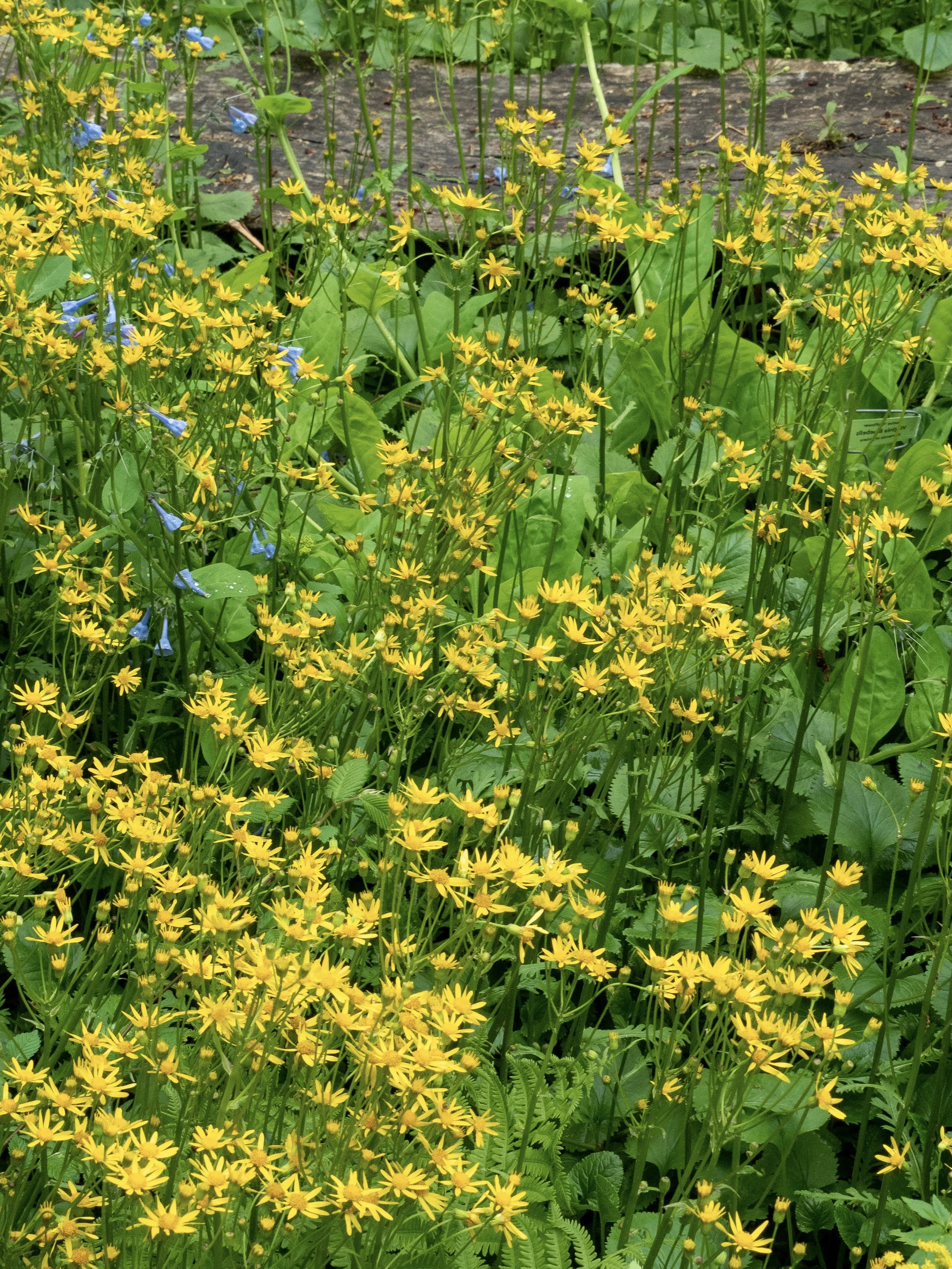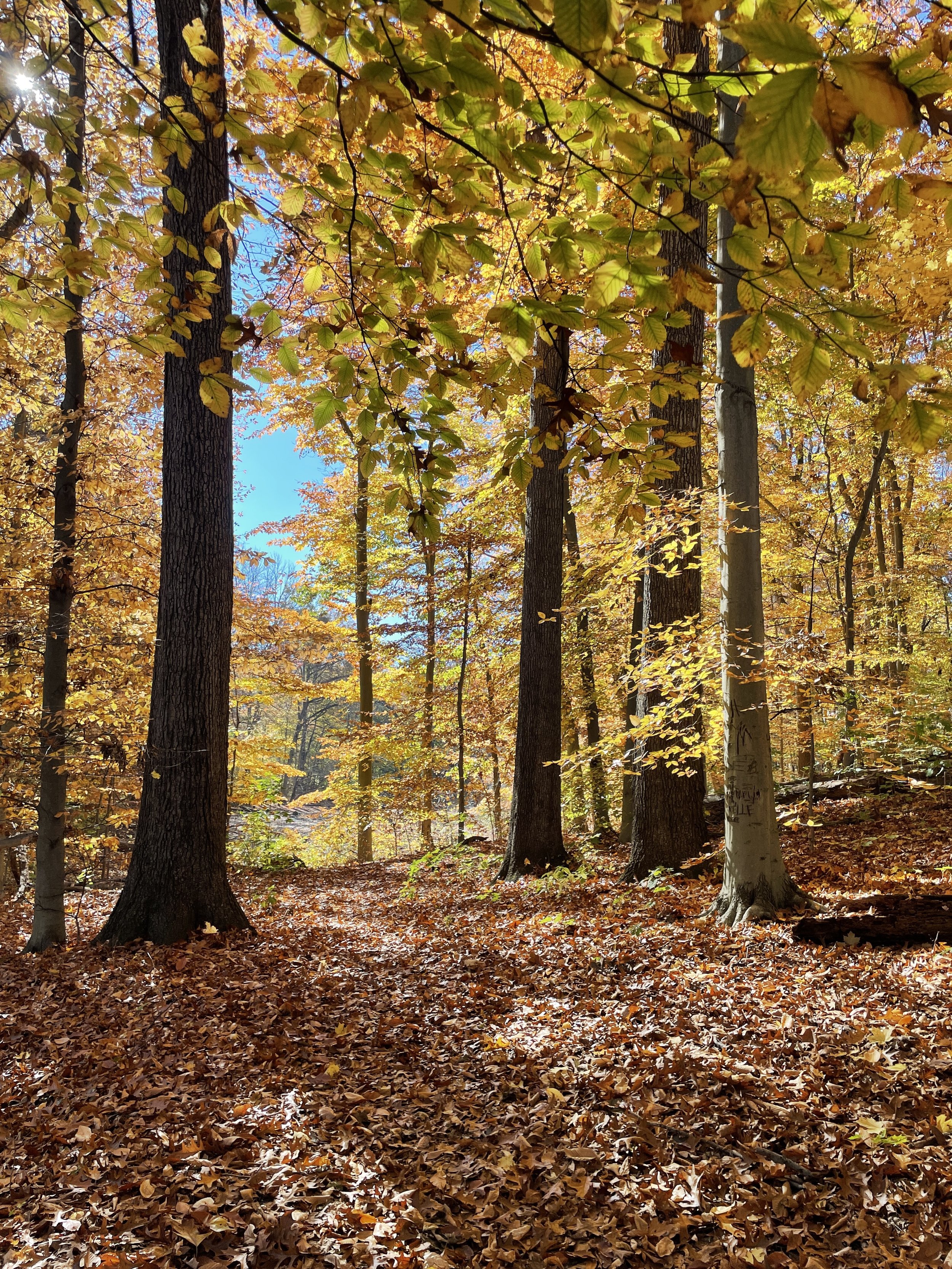Pollination
Pollination is an essential ecological survival function; nearly all the world’s seed plants need to be pollinated. Pollinators are responsible for bringing us one of out of every three bites of food, while also preventing soil erosion and increasing carbon sequestration. The Drew Forest, especially restored areas like the Zuck Arboretum and the Hepburn Woods, provides an indispensable pollinator-friendly habitat.
Who are the pollinators?
A bumble bee perched on Virginia Bluebells..
Bees travel from flower to flower picking up pollen on their furry coats to carry back to their nest. Many species of plants depend on pollen distribution by cross-pollination and bees happily feed on plant nectar. Bees are naturally docile and only attack when provoked, and provide humans with many ecological benefits
in return.
Bees:
Common Bee Species and Their Preferred Diet:
Mason Bee: Angelica, Dahlia, Goldenrod, Heath Aster, Heather, Ironweed, Joe-Pye-Weed, New England Aster, Obedient Plant, Sea Holly, Sedum, Sneezeweed, Turtlehead, Verbena, Woodland Aster
Butterflies perch on native flower species to hunt from nectar, collecting pollen on their legs that will aid in cross-pollinating. Butterflies pollinate during the day while flowers are open. They perceive color better than bees. Fun fact: bees cannot see the color red, but butterflies can!
Butterflies:
Common Butterfly Species and Their Preferred Diet:
Eastern Tiger Swallowtail: Candytuft, Chives, Eastern Red Columbine, Lilac, Lyreleaf Sage, Penstemon, Scabiosa, Sweet William, Wild Petunia, Woodland Phlox
Great Spangled Fritillary: Anise Hyssop, Bee Balm, Borage, Butterfly Bush, Cardinal Flower, Caryopteris, Coneflower, Garden Phlox, Heliotrope, Joe-Pye-Weed, Lantana, Petunia, Salvia, Sunflower, Swamp Milkweed, Tall Verbena, Zinnia
Bird pollination, called ornithophily, is carried out by hummingbirds, spiderhunters, sunbirds, honeycreepers, and honeyeaters. Birds are specifically essential for wildflower pollination. They are attracted to bright red, orange, or yellow flowers that produce plenty of nectar. Pollen sticks to the feathers of feeding birds, allowing for cross-pollination between plants. There are 2,000 bird species worldwide that feed on nectar, insects, and spiders associated with nectar-bearing flowers.
Common Bird Species and Their Preferred Diet:
Ruby Throated Hummingbird: (nectar plants) Abutilon, Aloe, Begonia, Canna, Cleome, Clover, Dahlia, Dianthus, Hollyhocks, Honeysuckle, Larkspur, Pentas, Zinnia, Ajuga, Baptisia, Bee Balm, Bleeding Heart, Cardinal Flower, Columbine, Coral Bells, Cranesbill, Crocosmia, Azalea, Black Locus, Blueberry, Cherry, Lilac, Maple, Witch Hazel, Morning Glory, Plum
Baltimore Oriole: Amaranth, Bachelor Button, Calendula, Grasses, Impatients, Millet, Snapdragons, Sunflowers, Agasthache, Asters, Black-eyed Susan, coneflower, Cup Plant, Lavender, Mallow, Milkweed, Stokesia, Thistle, Bayberry, Beautyberry, Blackberry, Dogwood, Elderberry, Hollies, Juniper, Mulberry, Raspberry, Serviceberry, Sumac, Viburum
Goldfinch: Alder, Beech, Conifers, Dogwood, Elm, Fruit Trees, Magnolia, Maples, Mulberry, Oak, Red Cedar, Redbud, River Birch, Willow, Arborvitae, Azalea, Buttonbush, Chokeberries, Clethra, Coralberry, Clethra, Elderberry, Hawthorn, Mountain Laurel, Rhododendron, Sumac, Viburnums, Virginia Creeper, Winterberry
Birds:
Golden ragwort is a New Jersey native wildflower in the Drew Forest that attracts plenty of pollinators.
Fall: Leave the Leaves!
Leaves in the Drew Forest can start to change color as early as mid-September all the way through November. The breathtaking fall foliage littering the forest floor isn’t litter at all — it’s actually food and shelter for a wide number of pollinating species.
Not all species migrate during the winter. The vast majority of butterflies and moths overwinter using leaves for winter cover from the weather and predators. These leaves become food for caterpillars when they emerge. Other animals that live in leaves like spiders, snails, worms, and millipedes are food sources for larger animals like chipmunks, turtles, and birds. Hibernating species like bumble bees only burrow only an inch or two into the earth for the winter, so a thick layer of leaves provides protection from the harsh elements.




